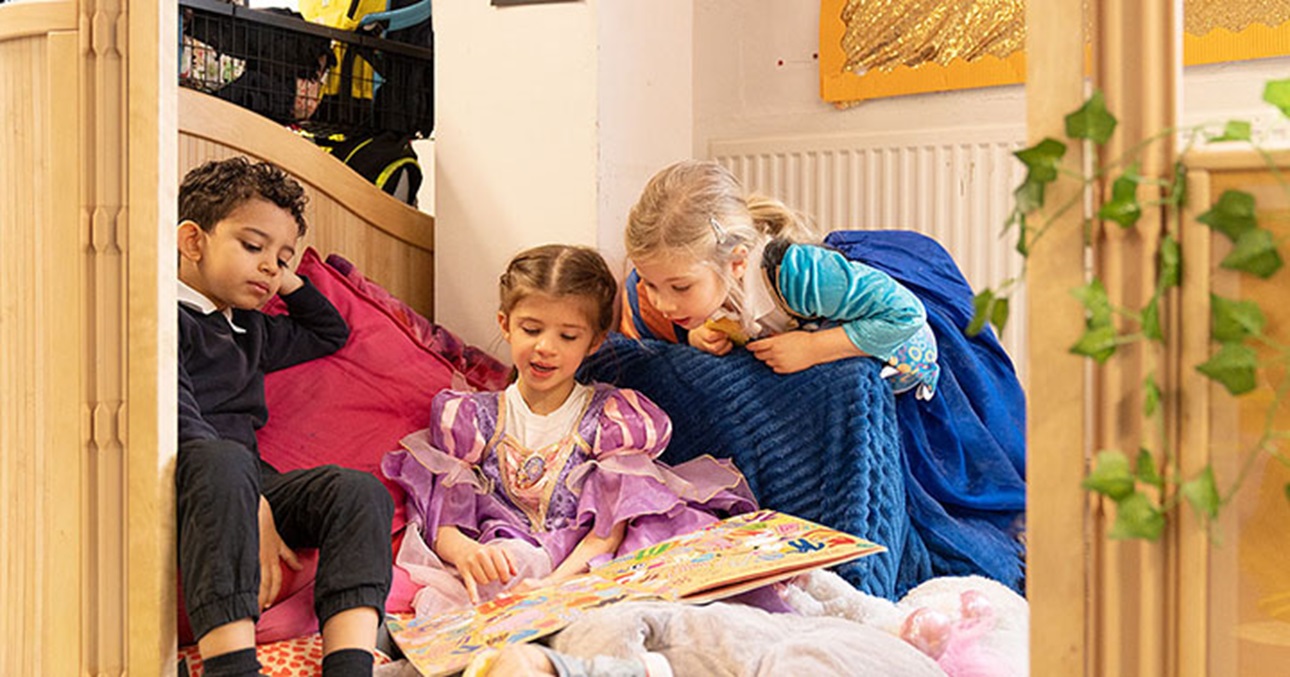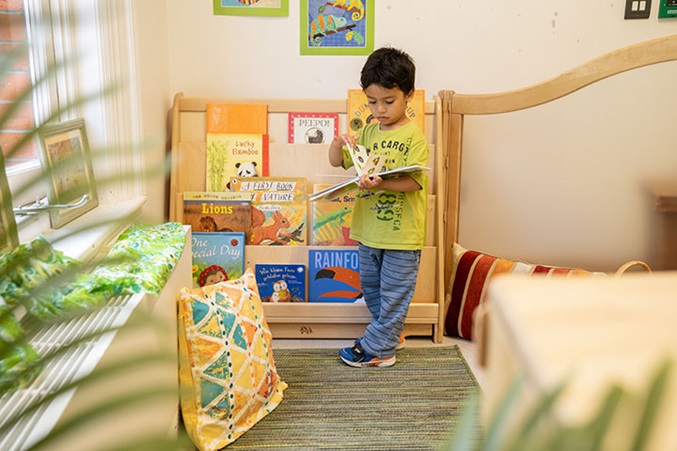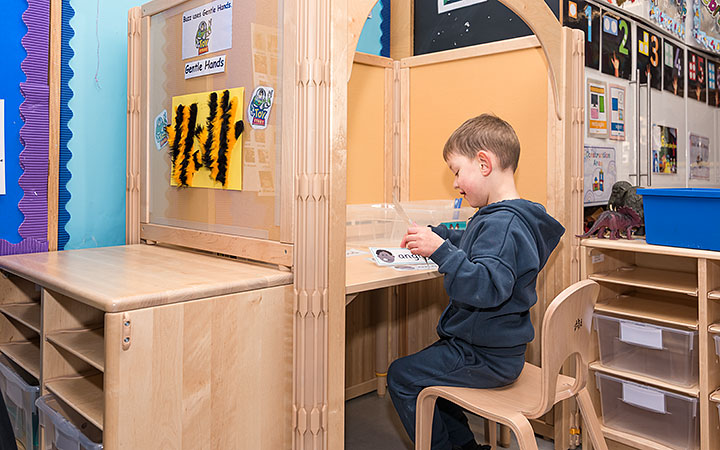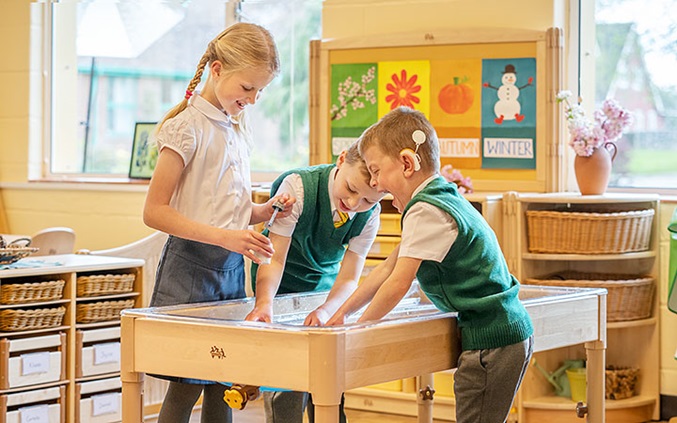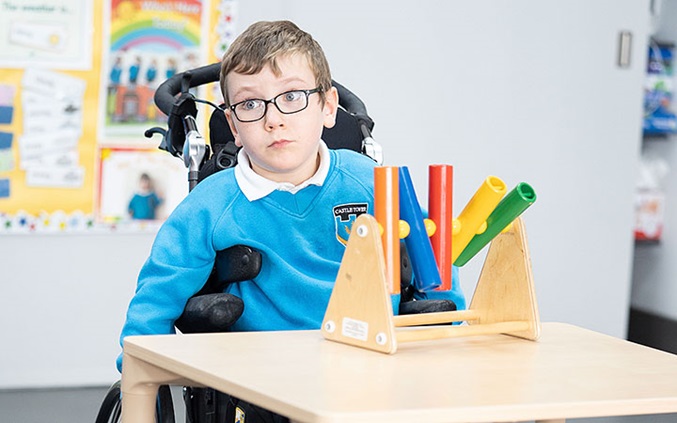Accessible environments for children with SEND
What makes an environment accessible?
| May 2023The terms “inclusive” and “enabling” are often used interchangeably, but they are separate concepts. Even if you create an amazing enabling environment, it may not be inclusive, and vice versa. An inclusive environment overcomes potential barriers to a child’s participation and learning. An enabling environment provides a stimulating learning space with rich opportunities for children to play, learn and investigate. Creating a high-quality and accessible learning environment requires both.
The indoor and outdoor environment
The indoor and outdoor environments should reflect and complement each other. They should encourage and support all areas of learning and development. Investing time and resources in creating a well-designed environment has a long-lasting impact on the quality of the practice you deliver. This benefits not only the children but also the practitioners, as it makes the environment easier to manage, maintain and keep safe. One of the biggest debates in classroom design is around aesthetics. Should it be bright and bold or natural and neutral? Having worked in both types of environments, I believe a blend and balance of both is best. This way you can meet the individual needs of all children within the classroom. For example, I once worked with a visually impaired child who couldn’t see the hessian-backed display boards as they lacked a clearly defined border. Similarly, a child with sensory processing difficulties found a bright and bold room too overstimulating. Although it is not possible to meet every child’s needs in every area of a room at the same time, an aesthetic that combines both bright and bold with natural and neutral elements is more inclusive and enabling for many children.
One effective approach is to use natural wooden furniture as a base and add colour through soft furnishings that can be easily removed. Each space should be designed purposefully, with consideration given to the desired ambience. For instance, quiet areas should have a low sensory stimulus design that is natural and neutral, while art areas can be bright and bold to encourage creativity and experimentation through colour and texture. Colour schemes can also help children identify specific areas and understand the expectations within them, such as speaking softly in calm areas and being energetic in bold and bright areas. It’s fascinating how naturally receptive and responsive children are to different aesthetics. This applies to the outdoor environment as well, which should reflect the indoor environment on a larger scale if space allows.
“Places of escape” in the classroom
A designated sensory or break-out room off the main classroom has obvious benefits, but it is also possible to recreate a place of escape within the classroom itself. This space should be calm and removed from the hustle and bustle of the room to support a child’s self-regulation. The child can access this area on their own or with adult support to co-regulate. Having this space within the classroom allows practitioners to respond to individual needs more readily without impacting staffing ratios. It also enables children to access the space freely throughout the day, and practitioners can recognise when a child may need a sensory break and direct them toward it. Some children may need time and space on their own without adult intervention, and having a place of escape within the classroom can provide this while maintaining high levels of safety and supervision. See a few examples here.
“Challenging behaviour”
As a SENDCo, I have always had a hard time accepting and using the term “challenging behaviour”. I feel that this term puts the blame on the children and implies that their behaviour needs to be fixed. However, my years of experience working with young children with SEND have taught me that a child’s actions are often a reaction to external factors, such as their learning environment. I have personally witnessed how small changes to the classroom layout can greatly enhance a child’s capacity to exhibit appropriate self-control. For example, in a classroom with an open plan and many vertical spaces between tables, children would often run and race across the room, despite constant reminders to walk. However, by slightly moving the furniture, we eliminated these “runways” and thus the disruptive behaviour.
When a child’s behaviour disrupts their own and their peers’ learning, I first examine the environment to identify potential triggers for that behaviour. If a child is shouting out, is it because the room is too noisy, and they cannot be heard? Do they need a quieter space? If a child is hurting others, is there enough space and resources for them to play alongside each other safely? If a child is climbing on furniture, do they have enough opportunities to do this in an appropriate and safe environment? I reflect on these questions and often find that making slight adjustments to the classroom can have a significant positive impact.
Workstations and continuous provision
Personally, I prefer classrooms with clearly defined areas for different resources and activities. This fosters predictability, encourages independent selection of activities and motivates children to put things back in their proper places. Workstations are a fantastic resource for any classroom, as they provide designated areas for children to work with all the necessary resources conveniently at hand. This promotes self-sufficiency and deep engagement with the learning activities. For example, one child in my class struggled to focus on an activity for more than a few seconds. However, they were immediately drawn to the new workstation, and having escaped the noise and distraction of the bustling classroom, got right to work and completed a task. You can only imagine the celebrations that followed.
View inclusive environments page for training videos and information about workstations.
Every area can benefit from continuous provision activities like sand, water and other sensory resources, as they offer children the opportunity to explore and regulate their senses. There have been times even as an educator when I’ve enjoyed the calming effect of pouring rice through my hands in a sensory tray or squeezing a lump of playdough.
It’s important to make these activities accessible to all children, regardless of their physical abilities or preferences for seating or standing. This includes providing tables and trays at different heights and considering adjustable furniture for children who use adaptive equipment. Some children prefer to sit on the floor, while others like to sit on a chair or stand. Having a range of floor and table trays of different shapes and sizes around the room can give children increased choice and accessibility to continuous provision. In one classroom I taught in, the fixed-height sensory table prevented children who used adaptive equipment or who preferred to sit down from freely accessing it. To solve this issue, I replaced it with an adjustable-height sensory table, which allowed all children to fully participate in the activity. This reasonable adjustment should also be considered for other furniture in the room, such as tables and chairs, to ensure they are suitable for all children in the room, particularly in mixed-age groups. By making these reasonable adjustments, we can ensure that all children can fully participate and engage in classroom activities, regardless of their abilities or ages.
Block play
Blocks should be easily accessible to children on a daily basis as they serve multiple purposes and support learning at any age and stage of development. Although blocks come in various shapes and sizes, I believe that every classroom should have large blocks available in the outdoor environment. This is because large blocks not only promote physical, imaginative, social and mathematical development but also support the sensory needs of children with SEND. Large blocks that children can easily pick up, carry and move around with their upper body provide opportunities for “heavy work”, an approach frequently used by occupational therapists to provide proprioceptive input to children through their muscles and joints. This approach can be particularly helpful for children with sensory processing difficulties as it can assist them in self-regulation.
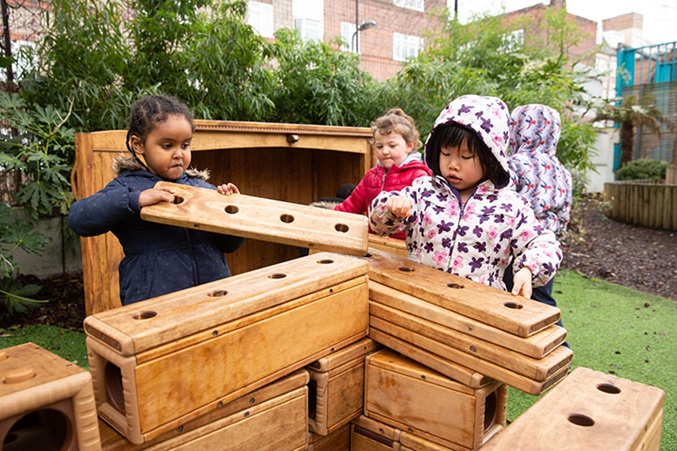
Reflection and change
In my experience, it’s crucial to continuously reflect on your environment as a practitioner. Setting up an indoor and outdoor environment should not be a one-time thing. Not every group of children that enters a classroom is the same, and just because a layout worked one year doesn’t mean it will work the next. As the year progresses, children’s needs can change, and as practitioners, we need to be responsive to this. The most common thing I hear from practitioners when I ask about the layout is “but it has always been like this”. Although change can be challenging, it’s important not to be afraid to make changes to reflect the needs of the children. Changing the layout of your indoor and outdoor environment can increase learning opportunities for children and positively impact their behaviour. Therefore, it’s important to take time to observe the children and consider which areas of the indoor and outdoor environments are working well and which are not. For areas that are working well, consider adding further resources or opportunities to extend learning. For areas that aren’t working well, think about what changes could be made to improve them. Walk around your indoor and outdoor environments and do an audit of the learning areas and resources available to the children, considering if they are relevant, appropriate and accessible. You could even take a group of children with you on your audit, as this provides an opportunity to collaborate and discuss the environment with them. Asking them what they like and dislike or what they would change or add provides insight into what is important to them. Our perspective of what an enabling and inclusive environment is could be very different from that of a child.
Summary
When children are in an accessible environment, barriers to participation are overcome and their learning and development flourish. Time, funding and resources should always be invested in creating such environments. Every new cohort has its own unique dynamic, and adjustments may need to be made to the environment, even as the year progresses. Investing in high-quality equipment can have a significant positive impact on the overall functionality of a classroom, both indoors and outdoors. By investing in the environment, costs can be reduced in other areas, for example, by creating a place of escape within the classroom, the need for an additional staff member to take a child outside of the classroom is reduced. Additionally, having height-adjustable furniture and resources, such as tables, chairs and sensory trays, makes them accessible to all children and transferable between classrooms, which is inherently practical and cost-effective. Overall, it is important to create and provide inclusive and enabling environments for all ages in order to facilitates optimal holistic learning.

